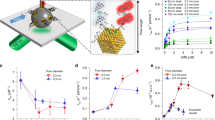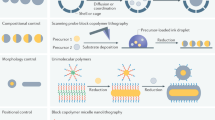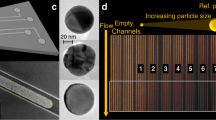Abstract
Metal nanoparticles are used as catalysts in a variety of important chemical reactions1,2, and can have a range of different shapes3,4,5,6,7,8, with facets and sites that differ in catalytic reactivity1,2,9. To develop better catalysts it is necessary to determine where catalysis occurs on such nanoparticles and what structures are more reactive. Surface science experiments or theory can be used to predict the reactivity of surfaces with a known structure1,2,10, and the reactivity of nanocatalysts can often be rationalized from a knowledge of their well-defined surface facets3,4,5. Here, we show that a knowledge of the surface facets of a gold nanorod catalyst is insufficient to predict its reactivity, and we must also consider defects on the surface of the nanorod. We use super-resolution fluorescence microscopy to quantify the catalysis of the nanorods at a temporal resolution of a single catalytic reaction and a spatial resolution of ∼40 nm. We find that within the same surface facets on the sides of a single nanorod, the reactivity is not constant and exhibits a gradient from the centre of the nanorod towards its two ends. Furthermore, the ratio of the reactivity at the ends of the nanorod to the reactivity at the sides varies significantly from nanorod to nanorod, even though they all have the same surface facets.
This is a preview of subscription content, access via your institution
Access options
Subscribe to this journal
Receive 12 print issues and online access
$259.00 per year
only $21.58 per issue
Buy this article
- Purchase on Springer Link
- Instant access to full article PDF
Prices may be subject to local taxes which are calculated during checkout




Similar content being viewed by others
References
Somorjai, G. A. & Li, Y. Introduction to Surface Chemistry and Catalysis 2nd edn (Wiley, 2010).
Ertl, G. Reactions at Solid Surfaces (Wiley, 2009).
Burda, C., Chen, X., Narayanan, R. & El-Sayed, M. A. Chemistry and properties of nanocrystals of different shapes. Chem. Rev. 105, 1025–1102 (2005).
Xia, Y., Xiong, Y., Lim, B. & Skrabalak, S. E. Shape-controlled synthesis of metal nanocrystals: simple chemistry meets complex physics? Angew. Chem. Int. Ed. 48, 60–103 (2009).
Lee, H. et al. Morphological control of catalytically active platinum nanocrystals. Angew. Chem. Int. Ed. 45, 7824–7828 (2006).
Murphy, C. J. et al. Gold nanorod crystal growth: from seed-mediated synthesis to nanoscale sculpting. Curr. Opin.Colloid Interface Sci. 16, 128–134 (2011).
Carbó-Argibay, E. et al. The crystalline structure of gold nanorods revisited: evidence for higher-index lateral facets. Angew. Chem. Int. Ed. 49, 9397–9400 (2010).
Katz-Boon, H. et al. Three-dimensional morphology and crystallography of gold nanorods. Nano Lett. 11, 273–278 (2011).
Weckhuysen, B. M. Chemical imaging of spatial heterogeneities in catalytic solids at different length and time scales. Angew. Chem. Int. Ed. 48, 4910–4943 (2009).
Nilsson, A., Pettersson, L. G. M. & Norskov, J. K. Chemical Bonding at Surfaces and Interfaces (Elsevier, 2008).
Botella, P., Corma, A. & Navarro, M. T. Single gold nanoparticles encapsulated in monodispersed regular spheres of mesostructured silica produced by pseudomorphic transformation. Chem. Mater. 19, 1979–1983 (2007).
Roeffaers, M. B. et al. Spatially resolved observation of crystal-face-dependent catalysis by single turnover counting. Nature 439, 572–575 (2006).
Xu, W., Kong, J. S., Yeh, Y-T. E. & Chen, P. Single-molecule nanocatalysis reveals heterogeneous reaction pathways and catalytic dynamics. Nature Mater. 7, 992–996 (2008).
Tachikawa, T., Yamashita, S. & Majima, T. Evidence for crystal-face-dependent TiO2 photocatalysis from single-molecule imaging and kinetic analysis. J. Am. Chem. Soc. 133, 7197–7204 (2011).
Novo, C., Funston, A. M. & Mulvaney, P. Direct observation of chemical reactions on single gold nanocrystals using surface plasmon spectroscopy. Nature Nanotech. 3, 598–602 (2008).
Tang, M. L., Liu, N., Dionne, J. A. & Alivisatos, A. P. Observations of shape-dependent hydrogen uptake trajectories from single nanocrystals. J. Am. Chem. Soc. 133, 13220–13223 (2011).
Meier, J., Friedrich, K. A. & Stimming, U. Novel method for the investigation of single nanoparticle reactivity. Discuss. Faraday Soc. 121, 365–372 (2002).
Tel-Vered, R. & Bard, A. J. Generation and detection of single metal nanoparticles using scanning electrochemical microscopy techniques. J. Phys. Chem. B 110, 25279–25287 (2006).
Eustis, S. & El-Sayed, M. Aspect ratio dependence of the enhanced fluorescence intensity of gold nanorods: experimental and simulation study. J. Phys. Chem. B 109, 16350–16356 (2005).
Geddes, C. D., Parfenov, A., Gryczynski, I. & Lakowicz, J. R. Luminescent blinking of gold nanoparticles. Chem. Phys. Lett. 380, 269–272 (2003).
Yildiz, A. et al. Myosin V walks hand-over-hand: single fluorophore imaging with 1.5-nm localization. Science 300, 2061–2065 (2003).
Michaelis, J. & Bräuchle, C. Reporters in the nanoworld: diffusion of single molecules in mesoporous materials. Chem. Soc. Rev. 39, 4731–4740 (2010).
Betzig, E. et al. Imaging intracellular fluorescent proteins at nanometer resolution. Science 313, 1642–1645 (2006).
Rust, M. J., Bates, M. & Zhuang, X. Sub-diffraction-limit imaging by stochastic optical reconstruction microscopy (STORM). Nature Methods 3, 793–796 (2006).
Hess, S. T., Girirajan, T. P. K. & Mason, M. D. Ultra-high resolution imaging by fluorescence photoactivation localization microscopy. Biophys. J. 91, 4258–4272 (2006).
Roeffaers, M. B. J. et al. Super-resolution reactivity mapping of nanostructured catalyst particles. Angew. Chem. Int. Ed. 48, 9285–9289 (2009).
Xu, W. et al. Single-molecule electrocatalysis by single-walled carbon nanotubes. Nano Lett. 9, 3968–3973 (2009).
Satterfield, C. N. Heterogeneous Catalysis in Practice (McGraw-Hill, 1980).
Wang, Z. L., Gao, R. P., Nikoobakht, B. & El-Sayed, M. A. Surface reconstruction of the unstable {110} surface in gold nanorods. J. Phys. Chem. B 104, 5417–5420 (2000).
Martin, J. J. & Armington, A. F. Effect of growth rate on quartz defects. J. Crys. Growth 62, 203–206 (1983).
Gulati, A., Liao, H. & Hafner, J. H. Monitoring gold nanorod synthesis by localized surface plasmon resonance. J. Phys. Chem. B 110, 22323–22327 (2006).
Zheng, H. et al. Observation of single colloidal platinum nanocrystal growth trajectories. Science 324, 1309–1312 (2009).
De Smit, E. et al. Nanoscale chemical imaging of a working catalyst by scanning transmission X-ray microscopy. Nature 456, 222–225 (2008).
Acknowledgements
The authors acknowledge the Army Research Office (W911NF0910232), National Science Foundation (CBET-0851257, to P.C.; DGE0903653, to E.C.), the US Department of Energy (DE-FG02-10ER16199) and the Sloan Research Fellowship for funding, E. Zubarev for gifts of gold nanorod samples and J. Sambur for comments. Part of the work was carried out at the Cornell Center for Materials Research (DMR-0520404) and the Cornell NanoScale Facility (ECS-0335765).
Author information
Authors and Affiliations
Contributions
P.C. conceived the experiments. X.Z. performed the experiments. N.M.A., G.L., E.C., K-S.H. and H.S. contributed to the experiments. X.Z. and P.C. analysed the data and wrote the paper.
Corresponding author
Ethics declarations
Competing interests
The authors declare no competing financial interests.
Supplementary information
Supplementary information
Supplementary information (PDF 10955 kb)
Rights and permissions
About this article
Cite this article
Zhou, X., Andoy, N., Liu, G. et al. Quantitative super-resolution imaging uncovers reactivity patterns on single nanocatalysts. Nature Nanotech 7, 237–241 (2012). https://doi.org/10.1038/nnano.2012.18
Received:
Accepted:
Published:
Issue Date:
DOI: https://doi.org/10.1038/nnano.2012.18
This article is cited by
-
Defocused imaging-based quantification of plasmon-induced distortion of single emitter emission
Light: Science & Applications (2023)
-
Dynamic imaging of interfacial electrochemistry on single Ag nanowires by azimuth-modulated plasmonic scattering interferometry
Nature Communications (2023)
-
Native diffusion of fluorogenic turn-on dyes accurately report interfacial chemical reaction locations
Analytical and Bioanalytical Chemistry (2023)
-
In situ identification of active sites during electrocatalytic hydrogen evolution
Nano Research (2023)
-
Inter-facet junction effects on particulate photoelectrodes
Nature Materials (2022)



